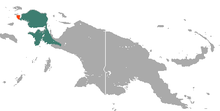Western long-beaked echidna
| Western long-beaked echidna | |
|---|---|
 |
|
| Scientific classification | |
| Kingdom: | Animalia |
| Phylum: | Chordata |
| Class: | Mammalia |
| Order: | Monotremata |
| Family: | Tachyglossidae |
| Genus: | Zaglossus |
| Species: | Z. bruijni |
| Binomial name | |
|
Zaglossus bruijni (Peters and Doria, 1876) |
|
 |
|
| Western long-beaked echidna range (green — extant, orange — possibly extinct) |
|
| Synonyms | |
|
Zaglossus bruijni (Peters & Doria, 1876) [orth. error] |
|
Zaglossus bruijni (Peters & Doria, 1876) [orth. error]
The western long-beaked echidna (Zaglossus bruijni) is one of the four extant echidnas and one of three species of Zaglossus that occur in New Guinea. Originally described as Tachyglossus bruijni, this is the type species of Zaglossus.
The western long-beaked echidna is present in the Bird's Head Peninsula and Foja Mountains of West Papua and Papua provinces, Indonesia, respectively, in regions of elevation between 1,300 and 4,000 metres (4,300 and 13,100 ft); it is absent from the southern lowlands and north coast. Its preferred habitats are alpine meadow and humid montane forests. Unlike the short-beaked echidna, which eats ants and termites, the long-beaked species eats earthworms. The long-beaked echidna is also larger than the short-beaked species, reaching up to 16.5 kilograms (36 lb); the snout is longer and turns downward; and the spines are almost indistinguishable from the long fur. It is distinguished from the other Zaglossus species by the number of claws on the fore and hind feet: three (rarely four). It is the largest extant monotreme.
The species is listed as Critically Endangered by the IUCN; numbers have decreased due to human activities including habitat loss and hunting. The long-beaked echidna is a delicacy, and although commercial hunting of the species has been banned by the Indonesian and Papua New Guinean governments, traditional hunting is permitted. In January 2013, an expedition led by Conservation International reported finding a population of the mammals as part of what they described as a "lost world" of wildlife in the Foja Mountains of Papua Province, Indonesia. A specimen collected in 1901 by John T. Tunney, later identified by Helgen et al. (2012), might prove that, in addition to New Guinea, the species inhabited the northern part of Western Australia (Kimberley) at least as recently as the beginning of the 20th century.
...
Wikipedia

